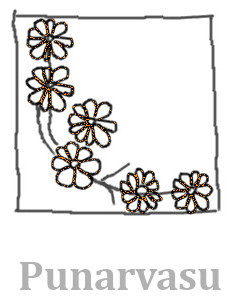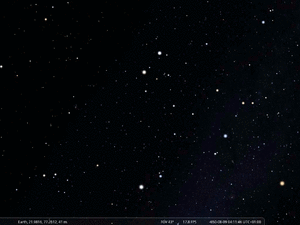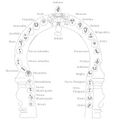Punarvasu: Difference between revisions
From All Skies Encyclopaedia
Punarvasu
No edit summary |
No edit summary |
||
| (6 intermediate revisions by the same user not shown) | |||
| Line 1: | Line 1: | ||
{{DISPLAYTITLE:}} |
{{DISPLAYTITLE:Punarvasu (पुनर्वसु)}} |
||
[[File:Punarvasu nakshatras in Temple draw+lbl 4ase.jpg|thumb|Punarvasu, in Tirupperunthurai (Athmanathaswamy temple) near Aranthangi, India, 10th century CE. (SMH 2025).]] |
|||
[[File:7 Punarvasu draw.png|thumb|Punarvasu asterism consisting of four stars, the brightest ones being alpha and beta Geminorum.]] |
|||
[[File:7 Punarvasu stellarium.gif|thumb|Punarvasu, 7th Nakshatra, mapped to the Stellarium star chart.]] |
[[File:7 Punarvasu stellarium.gif|thumb|Punarvasu, 7th Nakshatra, mapped to the Stellarium star chart.]] |
||
| ⚫ | |||
| ⚫ | Punarvasu (पुनर्वसु), "the twin-restorers of goods", is an Indian name, used by the Indian Vedic tradition. Most of these names are roughly 3000 years old. They pre-date Hinduism but were taken over by it. It is an asterism consisting of four stars, the brightest ones being alpha and beta Geminorum. |
||
==Etymology and History== |
==Etymology and History== |
||
'''Name Variants''' |
|||
What does the term mean, does it always have the same meaning - was it changed over time. |
|||
| ⚫ | |||
* Punarvasu (the two restorers), |
|||
* Yamakau ("the two chariots") |
|||
* Aditerbha |
|||
=== Origin of Constellation === |
=== Origin of Constellation === |
||
The name of the constellations is grammatically a dual, so it points to two similar stars/ asterisms. This way, it equals the idea of the Greco-Roman and Mesopotamian Twin-constellation where two bright stars head two similar, parallel chains of stars. |
|||
4 stars: α, β Geminorum are certain; the other two might be ε, ζ Gem |
|||
=== Transfer and Transformation of the Constellation === |
=== Transfer and Transformation of the Constellation === |
||
<gallery> |
|||
File:Punarvasu nakshatras in Temple draw+lbl 4ase.jpg|Punarvasu, 10th century CE |
|||
File:Nakshatra temple magDraw lbl.jpg|Display of all 28th nakshatras in silver arch with candles in Tirupperunthurai (Athmanathaswamy temple) near Aranthangi, India, 10th century CE. (SMH 2025). |
|||
File:Nakshatras in Temple draw+lbl 4ase.jpg|Display of all 28th nakshatras in a door frame in Tirupperunthurai (Athmanathaswamy temple) near Aranthangi, India, 10th century CE. (SMH 2025). |
|||
| ⚫ | |||
File:井宿(仏像図彙).png|Punarvasu, Chinese |
|||
File:चरकसंहिता of चरक. (IA dli.granth.16014).pdf |
|||
File:7 Punarvasu draw.png|Punarvasu as reconstructed by Jones (1720). |
|||
</gallery> |
|||
== Mythology == |
== Mythology == |
||
Latest revision as of 16:42, 30 October 2025
Punarvasu (पुनर्वसु), "the twin-restorers of goods", is an Indian name, used by the Indian Vedic tradition. Most of these names are roughly 3000 years old. They pre-date Hinduism but were taken over by it. It is an asterism consisting of four stars, the brightest ones being alpha and beta Geminorum.
Etymology and History
Name Variants
- Punarvasu (the two restorers),
- Yamakau ("the two chariots")
- Aditerbha
Origin of Constellation
The name of the constellations is grammatically a dual, so it points to two similar stars/ asterisms. This way, it equals the idea of the Greco-Roman and Mesopotamian Twin-constellation where two bright stars head two similar, parallel chains of stars.
4 stars: α, β Geminorum are certain; the other two might be ε, ζ Gem
Transfer and Transformation of the Constellation
Mythology
mnemonic tales and cultural significance
Weblinks
References
- References (general)












